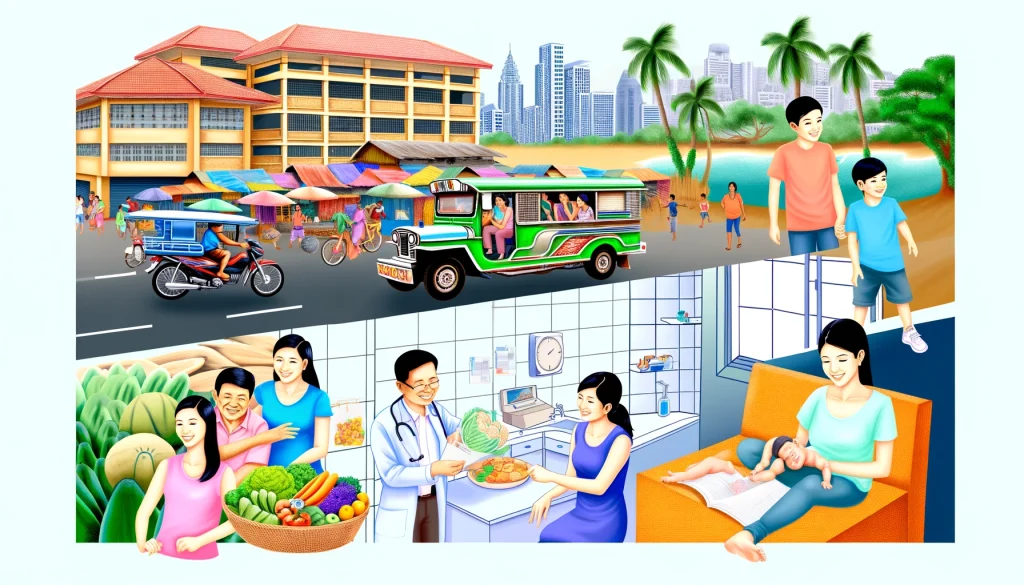Embracing life in the Philippines offers a unique blend of cultural richness, natural beauty, and welcoming communities.
However, understanding the cost of living is crucial for expatriates planning to call the Philippines their new home.
This guide delves into the various expenses you’ll encounter, from housing and utilities to food, transportation, and leisure, providing a comprehensive overview to help manage your finances effectively.
Housing and Utilities
Housing: The cost varies significantly depending on location and type of accommodation. In major cities like Manila and Cebu, a one-bedroom apartment in the city center averages between PHP 20,000 to PHP 50,000 per month, while outside the center the price drops to about PHP 10,000 to PHP 25,000. More affordable options are available in smaller cities and rural areas.
Utilities: For a standard apartment, expect to pay around PHP 4,000 to PHP 7,000 monthly for electricity, water, and garbage collection. Internet services average around PHP 1,500 to PHP 2,500 per month.
Food and Groceries
The Philippines offers a wide range of food options, from local markets to international supermarkets. A monthly grocery bill for one person can range from PHP 5,000 to PHP 10,000, depending on dietary preferences. Dining out is relatively affordable, with a meal at an inexpensive restaurant costing around PHP 200 to PHP 300.
Transportation
Public transportation is widely available, with jeepneys, tricycles, buses, and the metro being the most common modes. A monthly public transport pass costs around PHP 1,000 to PHP 2,000. For those preferring taxis, a starting fare is approximately PHP 40, with an additional PHP 13 to PHP 15 per kilometer.
Healthcare
While healthcare in the Philippines is more affordable than in many Western countries, expatriates often opt for private health insurance for broader coverage. Monthly premiums vary widely based on age, coverage, and provider but start at around PHP 2,500.
Education
For expatriates with children, international schools offer curriculums from American to British and International Baccalaureate. Annual tuition ranges from PHP 200,000 to over PHP 800,000, depending on the institution’s prestige and level of education.
Leisure and Miscellaneous
The Philippines is famed for its leisure activities, from beaches to hiking. Movie tickets cost around PHP 200 to PHP 300, and a gym membership averages PHP 2,000 per month. Miscellaneous expenses, including personal care and clothing, can vary greatly but generally remain affordable.
Tips for Managing Living Costs
- Embrace Local Markets: Fresh produce and local goods are cheaper and allow you to immerse yourself in Filipino culture.
- Utilize Public Transport: It’s not only cost-effective but also a way to experience daily life in the Philippines.
- Consider Provincial Living: Cities outside Metro Manila offer lower living costs with high-quality living standards.
- Healthcare Choices: Explore different health insurance options to find one that fits your needs and budget.
FAQs on Cost of Living, Budget, and Expenses for Living in the Philippines as a Foreigner
Can I Afford a Healthy Lifestyle?
Yes, maintaining a healthy lifestyle in the Philippines is achievable at a reasonable cost. The country offers an abundance of fresh food, sports facilities, and outdoor activities that are accessible. Additionally, healthcare costs are competitive, especially with the right local or international health insurance.
What’s the Cheapest Housing Option Available in the Philippines?
The most budget-friendly housing option in the Philippines is typically renting a room in a shared apartment or house. Prices vary greatly depending on the location, but it’s possible to find rooms for as low as PHP 3,000 to PHP 6,000 per month, particularly outside major metropolitan areas.
What are the Most Cost-Effective Places to Live in the Philippines?
Some of the most affordable and value-for-money places to live in the Philippines include cities like Davao, Iloilo, and Dumaguete. These areas offer lower living costs compared to Metro Manila, without significantly compromising on amenities and lifestyle.
Is It Possible to Have a Prosperous Lifestyle in the Philippines?
Yes, it’s possible to enjoy a prosperous lifestyle in the Philippines, especially if you have a steady income or savings. The cost of living is relatively low, allowing for a comfortable lifestyle that includes dining out, travel, and leisure activities.
Cost for Prolonged Stay in Rental Houses
For long-term stays, renting a house can cost anywhere from PHP 10,000 per month in more rural areas to PHP 50,000 or more in upscale neighborhoods in major cities. Prices depend on the location, size, and condition of the property.
Living in a Hotel in the Philippines
Staying in a hotel can be an option for short-term stays but might not be cost-effective long-term. Daily rates vary widely from PHP 1,000 for budget hotels to PHP 5,000 and up for luxury accommodations. Many hotels offer discounted rates for extended stays.
Cost of Food in the Philippines
The cost of food in the Philippines is quite affordable. Monthly groceries for one person might cost between PHP 5,000 to PHP 10,000, depending on dietary habits. Eating out at local restaurants can range from PHP 100 to PHP 500 per meal.
Cost of Urban Living
Living in urban areas, especially in Metro Manila, is generally more expensive than in provincial cities. Monthly expenses for a single person can range from PHP 50,000 to PHP 70,000, covering rent, utilities, food, transportation, and leisure activities, in a city center.
Understanding the cost of living, accommodation options, and lifestyle expenses in the Philippines can help foreigners plan their finances effectively.
With proper budgeting and choice of location, expatriates can enjoy a fulfilling life in the Philippines, from affordable living to experiencing the rich culture and natural beauty of the country.
Living in the Philippines as an expatriate can be an enriching and affordable experience with proper financial planning.
Costs vary by location and lifestyle, but overall, the country offers a competitive cost of living compared to many other expatriate destinations.
By understanding the typical expenses and making informed choices, you can enjoy all the beauty and warmth the Philippines has to offer without breaking the bank.



